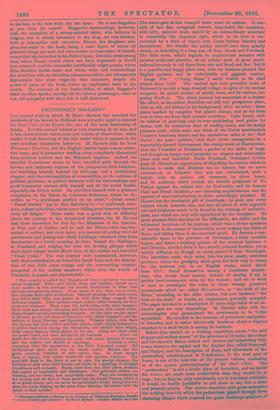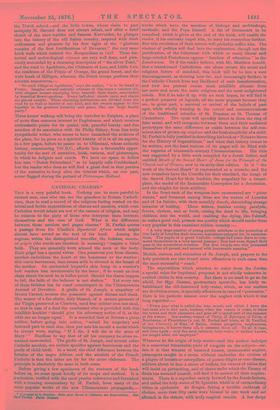PICTURESQUE HOLLAND.*
THE second work in which M. Henri Havard has recorded the incidents of his travels in Holland does not quite equal in interest his Dead Cities of the Znyder Zee, one of the most fascinating of
books. Yet this second volume is very charming in its way, and it has characteristic minuteness and 'variety of observation, which
render it well deserving of the title under which it appears in the very excellent translation before us. M. Havard calls his book Threatened Frontiers, but the English version bears a more attrac- tive name, and is pleasanter reading when completely dissociated from political notions and the Bismarck bugbear. Indeed, the cheerful Frenchman seems to have travelled gaily through the known and unknown regions of the prosperous little kingdom, not troubling himself, beyond his title-page and a preliminary
chapter, with the contemplation of eventualities, or the solution of political problems; in perfect harmony with his surroundings, and good-humoured content with himself and all the world beside, especially the Dutch world. He provided himself with a pleasant companion in the Baron de Constant-Rebecque, whom he de- scribes as "a gentleman grafted on an artist,"—(what would "David Garrick" say to that definition ?)—" a cultivated, ener- getic, robust individual, whose never-failing good-humour charmed away all fatigue." There really was a good deal of difficulty about the journey to the threatened frontiers, but M. Havard had them smoothed for him by the Ministers of the Interior, of War, and of Justice, and he and the Baron—who was war- ranted to endure, and even enjoy, any amount of poring over old parchments and poking into dusty buildings—steamed away from Amsterdam on a lovely morning in June, bound for Harlingen, in Friesland, and longing for even the fleeting glimpse which their rapid voyage would afford them of the solemn and beautiful "Dead Cities." The real journey only commenced, however, with their embarkation on board the Sneek boat, and the descrip- tion of that little canal voyage and the surrounding country, composed of the endless meadows which form the wealth of Friesland, is quaint and characteristic :-
' This country is called the Paradise of Cows,' and never was name better bestowed. White and black, shiny and healthy, buried up to their middle in rich herbage, the female inhabitants of these vast pastures are perfectly happy. From morn to eve, from eve to morn, they pursue their quiet occupation. Silently grazing, with sleepy eyes, they select their tufts, and gather in with their large tongues their delicious repasts. Their dreams cannot realise better fortune, for they sleep and ruminate. Then come the brick-kilns, with their immense black roofs and strange balconies, and lime-furnaces, with round, white, dome-shaped cupolas, resembling mosques. On the right are the spires of Iiitsum, on the left those of Francker, with shady ramparts, and the belfries of Ijnin, Winsum, and Spannum. Villages follow, with their tidy houses and their yellow and blue blinds, where thrifty housewives in golden head-tires throng the thresholds, and exhibit their bright, large copper flagons, which glitter in the sun. Along the whole route
we passed boats, and wore saluted by the boatmen Above our heads flew the storks, crossing the canal with much beating of wings;
also the toulpen, and flights of lapwings Nothing is more charming than the approaches to the little Friesland towns. Old fortifications have made way for shady walks. Behind lies the green country, redolent of new -mown hay. In front stretch lines of houses, with white woodwork and spotless windows. The good folk flock to the doors to see us pass, the gossips whisper, the children at play raise their heads,—all unite in a greeting of mingled friendliness and curiosity. Sneek, more than any other place, presents this aspect of hospitality and kindliness. The principal streets are winding, not too broad, and exquisitely clean. They are bordered by low houses, and the first of them leads into the Grand Square, which is of no great extent, and can never be particularly lively, seeing that two girls are lazily digging up the grass from between the stones with the points of their knives."
* Picturesque Milani: a formes, in the Proriscus of Friesland, Greningeu, Drenthe, 0 erysset, Gadder*, and Ltatbourg. By Henri Huard. London: &alloy end Son. The water-gate of this tranquil town must be curious. It con- sists of two fine octagonal towers, loop-holed for musketry, with lofty, pointed roofs, united by an extraordinary structure in something like Japanese style, which in its turn is sur- mounted by a kind of turret, with Louis-Quinze balcony and decorations. No wonder the author should have been greatly struck, on beholding it a long way off from Sneek and Friesland. The little town, which regards its architectural monster with peculiar pride and pleasure, as an artistic work of great merit, suffered severely in old times from war and flood and fire ; but it is a peaceful and happy place now, with its bastions planted Ian English gardens, and its redoubtable and gigantic warrior, "Lange Pier" (" Long Stone ") safely buried in its chief church since 1520. The ancient and once powerful town of Bolsward is merely a large tranquil village, in spite of its ancient ramparts, its grand avenue of stately trees, and its curious, im- posing StacThuis. The whole journey has somewhat of a dream- like effect, as the author describes one still and prosperous place, with an old, old history in the background, after another; these places marked by complete but placid change, and as far from ruin as they are from their ancient condition. Lake Sneek, with its bottom of peat-bog, and its ever-undulating reed plains for shores, with its numerous fleet of trading-boats, and its stately pleasure-craft, which make one think of the Dutch merchants in Cooper's American stories and the mysterious cabin of the Red Rover ;' the peat "polders," and their clever management by a remarkably shrewd Government, the orange wood at Heerenveen, once the Versailles of Friesland, a garden in the midst of bogs, and though no longer royal property, an elegant and aristocratic place rich and beautiful ; North Friesland, Groningen (which gives M. Havard an opportunity of dispelling the notion which he declares to exist, that Holland has no history, but we never entertained, or believed that any one entertained, such a belief), with its curious old treasures, its silver beans, and its archives, which include the terrible judgment of the Vehme against the valiant city, its University, and its famous Deaf and Dumb Institute,—are charming acquaintances, and the manner of one's introduction to them exceedingly pleasant. M. Havard has the invaluable gift of heartiness ; he goes into every subject which interests him, and into all about it, with impartial zest and briskness rarely to be found in the writings of archmolo- gists, and which are very well reproduced by the translator. He gives pleasant little sketches of the difficulties, the shifts, and the whimsical incidents of his journey, which was a choice specimen of variety in the means of locomotion, never making too much of them, and taking them in the cheeriest spirit. He devotes a con- siderable space to the province of Groningen, a truly enviable region, and draws a striking picture of the contrast between it and Drenthe, divided from it by a merely nominal frontier, yet as widely different as though an ocean parted it from Groningen. The travellers made their entry into the poor, sandy, wretched province, where the grudging earth gives her fruit only in return for the severest toil, in an English chaise, which dated from 1815; found themselves among a handsome popula- tion, who invest their money, instead of storing it up, in golden head-ornaments worn by the women ; and set to work at once to investigate the ruins of those strange primitive monuments which are called Hunnebedden, or "the beds of the Huns," according to the older version, but now rendered "the beds of the dead," or tombs, an explanation generally accepted. The pages devoted to a description of these huge relics of an un- known past are very interesting. M. Havard sides with the archteologista who pronounced the monuments to be Celtic sepulchres. He revelled in the museum of prehistoric antiquities at Drenthe, and is rather laboriously facetious about a chignon attached to a skull which is among its contents.
Before they started on a walking expedition across "the arid steppes and endless moors" of the province of Drenthe, the author and the cheerful Baron visited two curious and interesting little towns between the capital and the Zuyder Zee, called Steenwyk and Meppel, and his description of them, and afterwards of the penitentiary establishment of Veenhuiz' en, in the west part of Assen, is one of the best bite of the present volume, reminding us of the quaint picturesqueness of the Dead Cities. The " penitentiary " is not a severe place of detention, and no doubt the Menus are much more comfortable than they would be at large; but as they are only mendicants, not in any sense criminals, it would be hardly justifiable to put them in any but a glean and pleasant prison. The author describes with great animation the walking tour—in which the pedestrians passed through those charming villages which inspired the great landscape-painters of
the Dutch school —and the little towns, whose claim to past antiquity M. Havard does not always admits and after a brief sketch of the once warlike and famous Korvorden, he plunges into the history of the old Salian country, inspired with fresh enthusiasm and pleasure by his first sight of the "glorious remains of the first fortifications of Deventer," the very same brick walls which resisted the Burgundians in 1457. These his- torical and archeological resumi.s are very well done, and plea- santly succeeded by a charming description of "the silver Yssel," and the road to Apeldoorn, the Chateaux of Loo, and Little Loo, the residence of the Prince of Orange, the grand forest, and the wide heath of Milligen, whereon the Dutch troops perform their autumn manceuvres,—
" No such village as Apeldoorn," says the author, "is to be found in France. Imagine several majestic avenues of elm-trees a century old, with elegant houses emerging from beneath their shade, surrounded by beautiful flower-gardens. Every hall-door stands open, and chairs are placed outside. These charming habitations are divided from the road by no wall or barrier of any kind, and the owners appear to live together in the greatest harmony and peace, like one large family party."
Three hours' walking will bring the traveller to 'Zutphen, a place of more than common interest to Englishmen, and which receives enthusiastic praise for its quaint, rich, peaceful beauty, and due mention of its association with Sir Philip Sidney, from this truly sympathetic writer, who seems to have ransacked the archives of the place, for he gives us a spirited history of it in all its aspects, in a few pages, before he passes on to Oldenzaal, whose authntic history, commencing 700 B.C., affords him a favourable oppor- tunity for the sort of narrative, brisk, various, and picturesque, in which he delights and excels. We have no space to follow him into "Dutch Switzerland," as he happily calls Guelderland; but the reader who does so will find a great deal in that portion of the narrative to keep alive the interest which, on our part, never flagged during the perusal of Picturesque Holland.







































 Previous page
Previous page